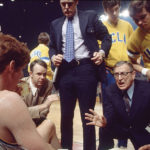Satchel Paige, a legendary Major League Baseball player who pitched until he was 50, always answered questions about his age by asking a question of his own: “How old would you be if you didn’t know how old you were?”
Dara Torres, an inspiration in her own right as the oldest member of the U.S. Olympic Swimming Team, recently answered the question with simple confidence: “I’d be 41. When you hit the water, the water doesn’t know what age you are.”
Eight years ago on the pool deck at the 2000 Sydney Olympics, moments after she captured a fifth medal that made her the Games’ most decorated female athlete, Torres flashed a bright but weary smile. She admitted to the world that she knew exactly how old she was then because she felt her age in every bone of her body. Sorry Satchel, but who could blame her?
Then 33, with one retirement party already eight years behind her, Torres was the oldest member of the U.S. Olympic Swimming Team. “I felt like I really didn’t have anything else to prove to myself,” she remembers. “Plus, I thought 33 was really old. And I was tired.”
Well, don’t look now—actually go ahead and look because Torres, often singled out for her beauty (she was the first athlete to pose alongside models in the Sports Illustrated swimsuit issue), appeared leaner, stronger and not a day older as the oldest member of the 2008 U.S. Olympic Swimming Team. This time at age 41.
Over seven days of competition, Torres certainly didn’t act—or swim—like the grande dame of her sport. There were no outward signs of weariness or exhaustion, only inspiration and respect flooding into the Water Cube, site of the Olympic swim competition, from all corners of the world.
Torres, a five-time Olympian is also a mother of a 2-year-old daughter. “Motherhood has been huge in my comeback because it motivates me to want to do well so I can explain all this to her when she gets a little older. I can’t wait to share this with her and have her understand,” she says. Torres has been heralded as a hero for men and women everywhere. Her e-mail inbox overflowed with congratulatory notes. Torres, in turn, fed off the public’s enthusiasm and good wishes at the Olympics. Not even the teasing from eight-time gold medal winner Michael Phelps, 23, who called Torres “Mom,” wiped the smile from her face.
“There are a lot of middle-aged men and women who I know that tell me that I’m an inspiration to them and they’re now doing things they thought they couldn’t do,” Torres says. “I’m hoping my age paves the way for other athletes who maybe think they’re too old to do something.”
Torres proved in Beijing that age was only a number. And her unwavering competitiveness was never more evident than on the final day of swimming at the Water Cube.
Torres capped her comeback for the middle-aged with two more silver medals, missing gold by one-hundredth of a second in the 50-meter freestyle. This after she regaled her Australian and German rivals with stories of giving birth to her daughter, Tessa Grace, two years ago. About 10 minutes after collecting her silver medal, posing for photographs and rushing into the locker room to retrieve her goggles, Torres ran back on deck to anchor the U.S. women to a runner-up finish in the 400 medley relay. Torres noted the quick turnaround, smiling and saying she did the same thing at the Sydney Olympics. “But I was only 33 then,” she says.
A lifetime ago. This is now, a new life.
Torres won silver in all three of her races in Beijing, earning her 12 medals in a career that began as a 17-year-old at the 1984 Olympics in her hometown of Los Angeles. Likely finished with competitive swimming, Torres is tied with fellow swimmer and four-time Olympian Jenny Thompson, now 35, for most medals ever won by an American woman. Natalie Coughlin, Torres’ teammate in Beijing, who turned 36 in August, won six medals to increase her career total to 11.
Torres admits she returned home thrilled with her effort, and she also realizes what it means for middle aged America. “If it helps anyone else out there who is in their middle-aged years, and they put off something they thought they couldn’t do because they were too old or maybe thought that, because they have children, they can’t balance what they want to do and be a parent, then I’m absolutely thrilled,” she says.
While Torres’ face may now actually show glimpses of her age, her 6-foot, 150-pound frame is chiseled and tight. Rowdy Gaines, the Olympic 100-meter freestyle champion at the 1984 Games, said of her, “It’s the perfect swimmer’s body; it’s the picture they’d draw in the dictionary.”
Mark Schubert, head coach and general manager of the U.S. team, credits Torres’ incredible fitness level for her success. “Dara Torres never ceases to amaze me,” Schubert told ESPN. “The only reason she could do this is she’s never been out of shape a day in her life. She loves to train and be fit.”
In a race that determined the world’s fastest woman swimmer, the 50-meter freestyle, also known as the “splash and dash,” Torres showed that her age wasn’t a barrier. She clocked the fastest time into the finals, recorded the second-fastest reaction time off the blocks in the finals and set an American record of 24.07. But she finished a fingertip behind German Britta Steffen’s time of 24.06, which prompted the personable Torres to say, “I realized I shouldn’t have filed my nails last night.” As she stood on the medal stand, she noted she was older than the gold and bronze medalists… combined! “I can’t tell you I often feel old,” she says. “But that about did it!”
Torres’ achievements, of course, have provoked consistent rumors that she must be cheating. Although Torres has not been accused of steroid use, talk of doping was so persistent that she flew to Colorado Springs and volunteered for an enhanced program that tests blood and urine more broadly for signs of doping.
When asked at the Beijing Olympics if she thought it was unfair that people looked at her age at times and questioned whether she had done it cleanly, Torres politely but firmly answered, “I am one of the few athletes who have asked to be tested. There’s nothing else I can say about that issue. I volunteered for the strictest testing program around. Period.”
Torres, who loves to win but not as much as she hates to lose, credited a rigid training regime for her success. Although she swims far less distance than she did while at the University of Florida in 1985—25,000 meters a week compared with 65,000 meters in college—Torres’ training shifted from heavy weightlifting toward coordinated movements and fluid timing. She was 12 pounds lighter and stronger than she was for the Sydney Olympics.
The first swimmer from the United States to compete in five Olympics—1984, 1988, 1992, 2000 and 2008—Torres indicates after Beijing that she plans to retire for good this time. But who is going to count out this Wonder Woman? She’ll be only 45 during Opening Ceremonies for the London Games in 2012.
On the pool deck following her last race, Torres was asked what she would tell daughter Tessa Grace of her Olympic experience. A smiling Torres didn’t hesitate. (Satchel, are you listening, too?) “You don’t have to put an age limit on your dreams.”







